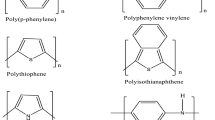Abstract
Semi-transparent and conducting thin film of poly(aniline-co-m-fluoroaniline) has been synthesized by a conventional oxidative copolymerization method using an aqueous solution of aniline, m-fluoroanilne as the monomers and ammonium persulfate as an oxidizing agent. The binding energy and crystalline behavior of copolymer have been characterized by XPS and XRD studies, respectively. The morphological and surface profile characterization has been performed by atomic force microscopy (AFM), and the thickness of the thin film (50–100 nm) has been studied by transmission electron microscope (TEM). An electrical AC conductivity of the copolymers has been measured in the low- and high-frequency regime. The permittivity of copolymer PA-co-m-FA50 has a higher value than polyaniline in the high-frequency regime and decreases with the increase of frequency. The composition of each copolymer has been confirmed by binding energies of C-C, C-N, and C-F in the XPS study. The dielectric behavior of PA-co-m-FA50 copolymer has been recorded in low- and high-frequency regime.











Similar content being viewed by others
References
Sharma AL, Saxena V, Annaporni S, Malhotra BD (2001) Synthesis and characterization of a copolymer:poly(aniline-co-flouroaniline). App J Polymer Sci 81:1460–1466
Haruna K, Alenaizan AA, Al-Saadi AA (2016) Density functional theory study of the substituent effect on the structure, conformation and vibrational spectra in halosubstituted anilines. RSC Adv 6:67794–67804
Astratinea L, Magnera E, Cassidyb J, Betts A (2012) Characterization and electrochromic properties of poly(2,3,5,6-tetrafluoroaniline): progress towards a transparent conducting polymer. Electrochim Acta 74:117–122
Kwon AH, Conklin JA, Makhinson M, Kaner RB (1997) Chemical synthesis and characterization of fluro-substituted polyaniline. Synth Met 84:95–96
Cihaner A, Onal AM (2002) Electrochemical behaviour and electrochemical polymerization of fluoro-substituted anilines. Polym Int 51:680–686
Niessen J, Schroder U, Rosenbaum M, Scholz F (2004) Fluorinated polyanilines as superior materials for electrocatalytic anodes in bacterial fuel cells. Electrochem Commun 6:571–575
Vivekanandan J, Vijayanand PS, Mahudeswaran A, Anandarasu R (2015) Synthesis, characterization and application of new poly(aniline-co-4-fluroaniline) DBSA nano-composites as conducting material. J Poly Mater 32:265–276
Waware US, Hamouda AMS, Shahul Hameed A, Summers GJ (2017) Synthesis and characterization of electrically conductive poly(aniline-co-3-bromoaniline) nanocomposites. J Mater Sci Mater Electron 28(14):10693–10699
Sharma AL (2009) Electrochemical synthesis of poly(aniline-co-fluoroaniline) films and their application as humidity sensing material. Thin Solid Films 517:3350–3356
Chen CX, Sun C, Gao YH (2008) Electrosynthesis of poly(aniline-co-p-aminophenol) having electrochemical properties in a wide pH range. Electrochim Acta 53:3021–3028
Liu SY, Cai Q, Zhu H, Jiang M (2005) Miscibility-complexation behavior and surface characterization of modified phenoxy resinpoly(butyl methacrylate-co-4-vinyl pyridine) blends. Chem J Chin Univ 26:1149–1155
Su YZ, Dong W, Zhang JH, Song JH, Zhang YH, Gong KC (2007) Poly[bis(2-aminophenyloxy)disulfide]: a polyaniline derivative containing disulfide bonds as a cathode material for lithium battery. Polymer 48:165–173
Fusalba F, Belanger D (1999) Electropolymerization of polypyrrole and polyaniline-polypyrrole from organic acid medium. J Phys Chem B 103:9044–9054
Han C-C, Chen H-Y (2007) Highly conductive and electroactive fluorine-functionalized polyanilines. Macromolecules 40:8969–8973
Ghose S, Kalpagam V (1989) Solvent effect on the electronic absorption spectra of polyaniline. Synth Met 33:11–17
Yue J, Zhao HW, Cromack KR, Epstein AJ, MacDiarmid AG (1991) Effect of sulfonic acid group on polyaniline backbone. J Am Chem Soc 113:2665–2671
Santhosh P, Gopalan A, Vasudevan T (2003) In situ UV–visible spectroelectrochemical studies on the copolymerization of diphenylamine with ortho-methoxy aniline. Spectrochim Acta A 59:1427–1439
Waware US, Rashid M, Summers GJ (2016) Poly(aniline-o-bromoaniline) and poly(aniline-o-fluoroaniline): A comparative study of their physical properties. J Adv Phys 6:269–273
Ramaswamy M, Malayandi T, Subramanian S, Srinivasalu J, Rangaswamy M (2017) Magnesium ion conducting polyvinyl alcohol–polyvinyl pyrrolidone-based blend polymer electrolyte. Ionics 23:1771–1781
Acknowledgements
The authors are thankful to the Qatar University and the Department of Chemistry, Aligarh College of Education, for providing necessary research facilities.
Author information
Authors and Affiliations
Corresponding authors
Rights and permissions
About this article
Cite this article
Waware, U.S., Hamouda, A.M.S., Rashid, M. et al. Binding energy, structural, and dielectric properties of thin film of poly(aniline-co-m-fluoroaniline). Ionics 24, 3249–3257 (2018). https://doi.org/10.1007/s11581-018-2516-4
Received:
Revised:
Accepted:
Published:
Issue Date:
DOI: https://doi.org/10.1007/s11581-018-2516-4




